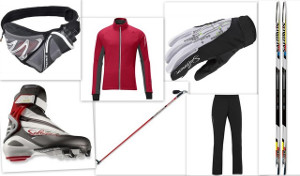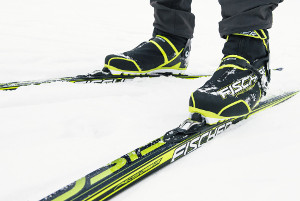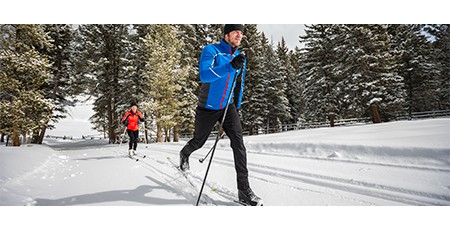 Nordic skiing is a steadily-growing winter sport, and for good reason. The workout value is incredible, and it allows you to see beautiful, peaceful places. It is a great way to work the muscles in your legs, arms, shoulders, back, and core. Gliding and kicking on two skis is an incredible aerobic challenge, without the pounding on your joints that sports like running or basketball create. When compared to downhill skiing, nordic skiing is accessible for many and quite inexpensive.
Nordic skiing is a steadily-growing winter sport, and for good reason. The workout value is incredible, and it allows you to see beautiful, peaceful places. It is a great way to work the muscles in your legs, arms, shoulders, back, and core. Gliding and kicking on two skis is an incredible aerobic challenge, without the pounding on your joints that sports like running or basketball create. When compared to downhill skiing, nordic skiing is accessible for many and quite inexpensive.
Whether you are a beginner skier, or a new nordic ski parent of an aspiring skier, learning about the gear is Step #1. We wrote this piece specifically for people who are new to the sport, have a child entering the sport, or are simply exploring the sport.
Here are the things you will need as an entry-level nordic skier.
Skis
The most important gear for skiing, not surprising, is the pair of skis. If you will just be skiing for one trip, you can easily rent them, or you can invest in purchasing if it is going to become a regular hobby. There are two major decisions to make when it comes to skis: The first decision is a biggie: To choose a ski style — Classic or Skate.
The good news is that, regardless of which ski style you choose, if you are coming from the world of alpine skiing, you will find Nordic skis to generally run about 50% of the cost of downhill skis of the same quality and level. Compared to downhill skiing, Nordic tends to be a bit less expensive.
Classic skis are more common, provide for the front-to-back thrusting motion, and are the skis that probably are more universal on most ski trails. Skate skis require more of an ice-skating motion that has the powerful thrust going out to the sides. While perhaps a little less common, most good trail systems have plenty of skate trails to use. Skating allows for speeds that are about 15% faster, and also provides for a higher overall cardio workout level.
You can do the skate-skiing technique on classic skis if you need. It is difficult, though, to do the classic technique on skate skis. Most kids who join a nordic ski team or league will be taught to skate ski for better speed, but they can do this on classic skis if you are trying to keep your investment as a manageable level. Plus, the classic skis will be more all-purposes when it comes to recreational trails.
Next, think about waxable vs. waxless. For the skis that are waxed for temperature and snow conditions, you can better respond to conditions because of the fine glide. On the other hand, waxless skis offer a firm grip on the snow by means of the tiny fish scales that are present on the underside of the skis. Some skis are cut shorter than advanced ones, for maneuverability and offer more stability while compromising on speed. This modification is made for beginning skiers.
If you are just starting out, and unsure of what kind of skiing you will enjoy, we recommend renting until you settle on a style of skiing and preferred investment amount.
 Ski Boots
Ski Boots
There are plenty of options availble on the market, but getting your hands on a perfect pair of ski boots should be your utmost priority. After all, the boots are the main point of contact between your body, and the snow you are trying to travel over.
The best cross-country ski boots offer maximum stability and comfort for a skier. Ski boots now come with several mods to help maximize the fun experience of skiing without any discomfort. Ski boots come with a speed lacing system that makes it possible to fit and settle nicely around the contours of your feet. Other features to look for are the overall padding level, especially in the tongue, which will help the foot fit snugly yet comfortably. Modern ski boots come with an HF heel counter. It is carefully integrated and cups the foot so that you won’t twist it while on the track, something that tends to be an issue when you are cruising along at top speed. This extra feature also controls the torsional stability and downhill control. Finally, your ski boots should be light weight so that you can glide easily.
As for our favorite ski boots, it really depends on your goals However, for a versatile boot, we have always liked the Alpina Blazer. They have a comfortable fit, stability, torsional control and most importantly, lightweight construction for the beginners.
Poles
Poles are an important piece of ski gear, and arguably play a more important role in nordic than in alpine skiing. Poles help you in a number of ways. They provide you balance, help you to skate, and aid in maneuvering. Most importantly, they allow you to increase your overall power and speed. A strong pole stroke is really part of any good ski push. They are always available in pairs and measured in either a two inch or five-centimeter increment.
For beginners, finding the right ski pole size is vital. If your poles are too long, it will result in loss of control and responsiveness — and getting tangled up with poles has been the cause of more than one broken collar bone. On the other hand, if they are too short, they force you to bend to far forward. Therefore finding the perfect length is very important. For parents, expect that you will need to upgrade your poles as your child grows. The benefit of getting higher end ski poles is they help provide better balance and a lower swing weight that in turn makes your skiing experience efficient.
Poles are a little longer for skate-skiing than for classic. For classic, they should come to about the top of your shoulder, when standing straight up. Skate-skiing poles are generally about 10 cm longer. Nordic poles feel quite long compared to Alpine poles, which typically only come up to your stomach area.
Hat and Goggles

While ski helmets have become the norm for downhill skiing, most nordic skiers opt for a good, versatile hat. The lower top speed and predictably of nordic ski trails make head protection less essential. However, if you are unsure of your skills or will be on hilly trails that challenge your ability level, by all means consider a helmet. We have been on many ski trails across the country that had us worried about a hard spill, when you combine hilly terrain with nearby trees.
As for hats, we like the same hats that are popular for cold weather running and other winter aerobic activities. Brands like The North Face, Smartwool, and UnderArmor have made hats that perform very well on the nordic trails.
Don’t overlook your eyes. The UV rays there are intense and bounce off of the white snow directly into your eyes and can cause snow blindness. Additionally, you need protection from the blowing wind and snow. A good pair of athletic, wrap-around sunglasses can be a good investing for warmer conditions, and when it is colder you should look for professional goggles made for skiing.
What to wear?
It can be a Jekyl and Hyde situation when it comes to dressing for nordic skiing. Sure, you need to stay warm, but within a few minutes of getting your heart rate up you will find yourself heating up and actually getting sweaty. You need clothing that protects you from elements, while allowing your body to cool itself.
Competitive and elite nordic skiers will race in one-or-two-piece race suit, a moisture-wicking knit that is highly-technical and built for racing. However, most of us are not elite nordic racers!
The first thing to consider is your base layer. The base layer serves two purposes; insulating you from the cold and in wicking away sweat. We never recommend skimping on a base layer, because it creates the foundation for your comfort on the trails. Plus, most base layers can be used for other activities such as cold-weather running or hiking. Any skier knows that a good base layer is the foundation of comfort on the trails.
You also need quality ski socks. These socks should fit snugly and work well with your boots and base layer system. Always go for  good quality socks so that you won’t chafe your feet.
good quality socks so that you won’t chafe your feet.
Ski jackets and tights are insulated to varying degrees. They highly influence the other layers you choose. Look for a good quality jacket with a lot of pockets. As for tights, you will find Nordic-specific ski tights on the market. They are bulkier than running tights, but much thinner than alpine ski pants. Be sure that your outerwear also features breathable fabric and waterproof materials.
Good ski gloves essential to skiing, and it makes sense to own a couple different pairs for warmer vs. cooler days. Don’t skimp on the gloves! Having wet or cold hands can really be a buzzkill on an otherwise good ski day on the trails. Keep in mind that gloves will lose their insulative properties before they look like they are worn out, so keep your gloves current and don’t let them get too old.
Final Thoughts
Don’t skimp on gear. We know that everyone has a budget they need to work within, but investing in the right gear from Day 1 will allow you to not worry about the elements, and instead focus on improving your skill and enjoy the great sport of Nordic skiing.

Paul Miller is the Founder of Family Skier. He is an advanced skier and has extensive experience with family travel and ski schools. An accomplished skier, he has skied in 15 states and provinces and 6 countries. In addition to FamilySkier, his writing can be found on many ski-related websites, and as curriculum for many ski clubs in North America.




